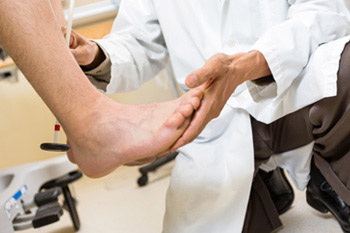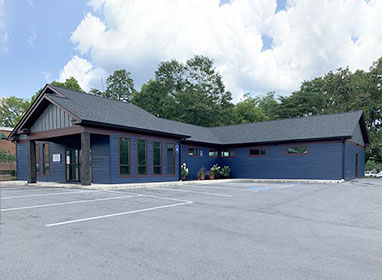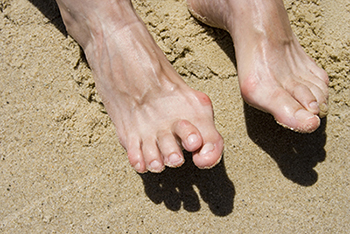
Podiatrist Stephan J. LaPointe, DPM, PhD, FACFAS of Georgia Foot & Ankle Specialists is dedicated to providing the highest quality foot and ankle care. With one office conveniently located in Rome, Georgia, Dr. LaPointe is the only podiatrist in the area board certified in both Forefoot and Rearfoot and Reconstructive Rearfoot and Ankle Surgery. He is the only podiatrist in the country with three years of surgical training and a Ph.D. in Biomedical Engineering. His thesis and focus was on lateral ankle instability and how to surgically repair it. Dr. LaPointe is a faculty member of the Podiatry Institute and is constantly lecturing on his work and research.
Dr. LaPointe provides treatment for a variety of podiatric conditions, such as heel pain and fungal nails, and offers sports medicine and surgical procedures. Georgia Foot & Ankle Specialists accepts most insurance plans and welcomes new patients! We are following the recommended guidelines of the CDC and are requiring that masks are worn when entering the office.
To schedule an appointment, call our office today! (706) 232-3888
 A podiatrist, or Doctor of Podiatric Medicine (DPM), is a professional who is trained in the treatment of injuries or issues concerning a person's feet, ankles, or areas of the lower leg. When it comes to treatments, podiatrists have the ability to reset broken bones, prescribe drugs, request lab tests or x-rays, as well as perform surgery.
A podiatrist, or Doctor of Podiatric Medicine (DPM), is a professional who is trained in the treatment of injuries or issues concerning a person's feet, ankles, or areas of the lower leg. When it comes to treatments, podiatrists have the ability to reset broken bones, prescribe drugs, request lab tests or x-rays, as well as perform surgery.
To become a podiatrist, one must complete 4 years of medical school, as well as 3 years of a residency where they gain real world experience working at a hospital. After those two requirements are completed, some choose to gain further certifications by the American Board of Podiatric Medicine (ABPM) in areas such as surgery of the foot and ankle.
A podiatrist may be of help to you if you are experiencing pain or discomfort due to conditions such as hammertoes, bunions, arthritis, heel pain, ingrown toenails, corns, calluses, fungal nails, flat feet, plantar warts, or athlete’s foot, to name a few. They can also be useful if you are curious about maintaining general care for your feet, picking the correct shoe size, obtaining footwear inserts or orthotics, as well as suggesting stretches or exercises to help strengthen your feet.
If you’re experiencing any problems involving your feet, ankles, or lower leg areas, it is highly recommended that you consult with a podiatrist near you for a proper diagnosis and treatment regime.
To ensure your convenience, below is the information you need about our podiatry office, including our hours, location, appointment scheduling and insurance acceptance.
Appointments
If, for any reason, you cannot keep a scheduled appointment or will be delayed, please call as soon as possible. Charges may be incurred for appointments cancelled less than 24 hours before scheduled appointment time.
Insurance
Our office accepts a variety of PPOs, and other health plans. Please call our office to verify acceptance of your insurance carrier.


Hammertoes can be identified by an abnormal bend in the middle joint of the toe. This abnormal bending can lead to added pressure on the toe when wearing shoes. It can also cause pain or discomfort when walking or running. Because hammertoes typically worsen overtime and become increasingly more rigid, it’s recommended that you seek the help of a podiatrist for treatment options if you believe you’re experiencing the symptoms of this deformity.
Those experiencing hammertoe may also find other foot related issues that come with this condition, such as corns or calluses. Some factors that may influence your likelihood of getting hammertoe include old age, toe length, improper footwear, and genetics. Those who have diabetes or arthritis are also more likely to have foot related complications, including hammertoe.
To help better prevent yourself from getting hammertoe, it’s recommended that you avoid wearing shoes that limit the room for your toes. Footwear with low heels, as well as adjustable straps or laces, can be useful when it comes to providing your feet with ample room to move. Buying shoes that fit are also important, which is why we recommend shopping at the end of the day when your feet are at their largest. This helps you avoid choosing a shoe too small for your feet.
Orthotics, as well as medical pads for corns and calluses that may develop due to your hammertoe, are recommended to help relieve discomfort. Light toe exercises may also be helpful for strengthening the muscles and mobility of your toes.
For a proper diagnosis and recommended treatment plan, we suggest you consult with a podiatrist for professional help and care.

As with any sporting activity, it’s very important to be aware of the safety precautions needed to help avoid injury and reduce risk. With that being said, injuries of the foot and ankle are fairly common among those who actively participate in sports.
Some sports may be considered more dangerous in terms of foot and ankle injuries compared to others. These sports may include basketball, running, football, soccer, and dancing. Sports that require tightly worn shoes as well as have a particular focus on jumping typically run a higher risk of injury. Because the feet are considered the foundation of the body, help us stay balanced, and enable us to perform our everyday activities, professional help should be sought at the first instinct of something gone wrong.
Some common contributors that lead to foot and ankle injuries in the realm of sports include not stretching properly or failing to warm up, wearing the incorrect footwear needed for your particular sport, as well as not taping or providing your feet and ankle with the needed support. There are a number of foot conditions that can develop if certain safety measures are ignored. Some of the most common conditions related to sports injuries include Achilles tendinitis, plantar fasciitis, and stress fractures, to name a few.
Achilles tendinitis affects the largest tendon in the body, the Achilles tendon. This type of injury typically occurs because of overuse. The main function of the Achilles tendon is to transmit power from the calf muscles to the heel and the foot. When this tendon is harmed, it can be extremely painful and may lead to further complications including tears, ruptures, tendinitis, peritendinitis, tendinosis, tendinopathy, and bursitis.
Plantar fasciitis may occur when the band of tissues that support the arch of your foot experience too much stress. These tissues can become strained from frequently performing sporting activities, thus causing inflammation and pain at the bottom of the heel.
Stress fractures can arise due to a lack of conditioning, use of improper equipment or technique, and repetitive stress placed on the foot and ankle. A stress fracture is a small crack in the bone that can be very painful and cause a great deal of discomfort.
If you commonly participate in sporting activities and would like more information about how to keep your feet and ankles safe, as well as learn more about your treatment options if injured, we recommend you speak with a podiatrist for professional guidance and care.

When it comes to receiving foot and ankle surgery, it’s typically a case by case situation. Some factors that play a role in whether or not you need surgery include the severity of your symptoms as well as your response to other conservative, noninvasive treatment methods.
There are a number of different foot and ankle conditions that may benefit from surgery as a treatment option. Bunions, hammertoe, metatarsal, ankle arthritis, Achilles tendon disorders, Morton’s neuroma, tibialis posterior disorder, and plantar fasciitis are all conditions that may require surgery as a treatment option, depending on their severity. Long-lasting pain relief is typically the biggest takeaway from having surgery performed to remedy your condition.
In order to best prepare for surgery, make sure you have a consultation with your podiatrist about your overall health, discuss any possible changes in medication, and ask any questions you may have about the procedure to go into the treatment with a clear head. In some cases, you may have to refrain from eating and drinking a few hours before the procedure, so make sure you understand what must be done on your end beforehand.
As for recovery, again, this will typically vary case by case and will be dependent on your condition and the type of surgery performed. Generally, it’s recommended that you get plenty of rest, ice the affected area, compress the wound to aid in further strain, and keep the area elevated to reduce any possible swelling. In some cases, your podiatrist may encourage you to use bandages, splints, surgical shoes, casts, crutches, orthotics, or a cane, depending on how much weight they believe your foot and ankle can bear.
If you’d like to determine whether surgery is the best option for you and your foot condition, consult with a podiatrist who will be able to give you a proper diagnosis and aid you with your decision.